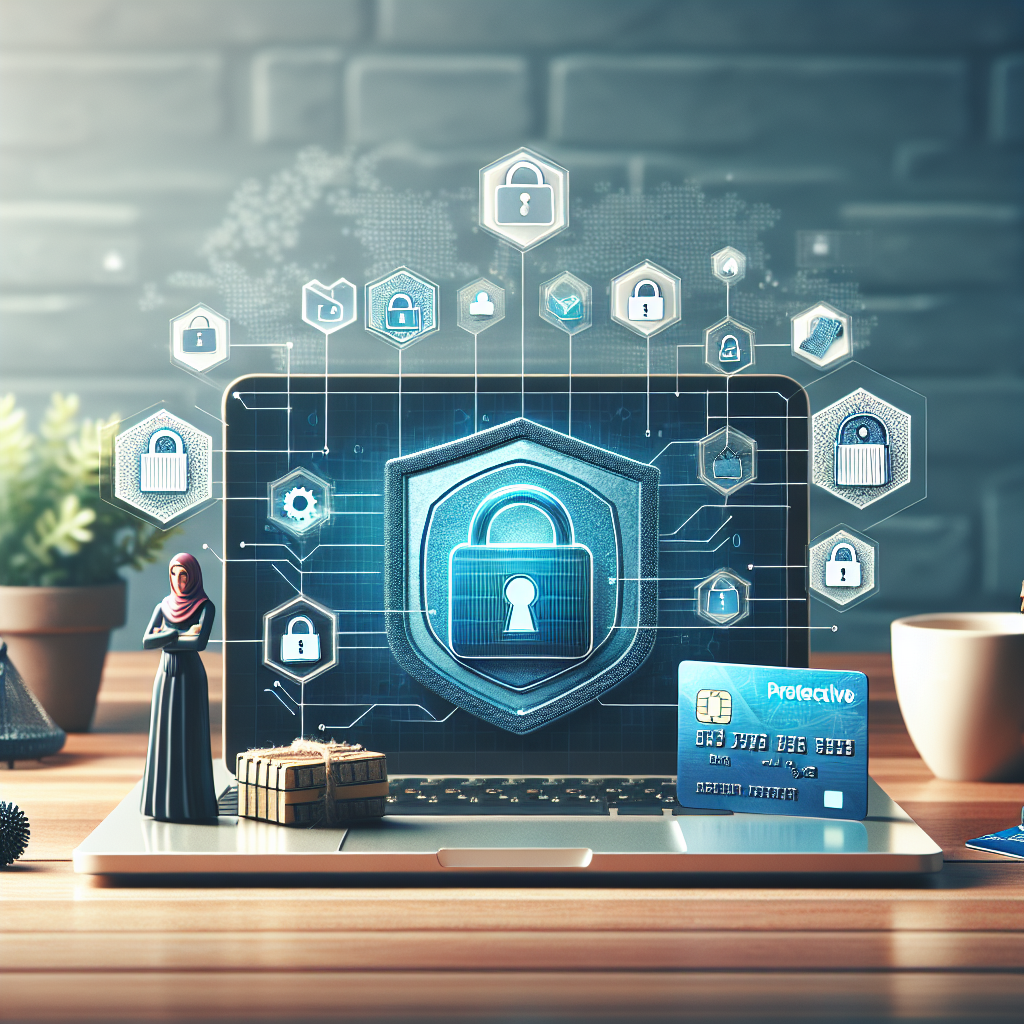In today’s digital age, online shopping has become increasingly popular for its convenience and high speed internet accessibility. However, with the rise of cyber threats and hackers, ensuring a safe and secure online shopping experience is more important than ever. This guide provides essential cybersecurity tips to help protect yourself while shopping online. From using strong and unique passwords to being cautious of phishing scams, these valuable insights will empower you to navigate the virtual marketplace with confidence. By implementing these cybersecurity measures, you can shop online with peace of mind and safeguard your sensitive information from potential threats.
Understanding Cybersecurity Risks in Online Shopping
In the digital age, cybersecurity plays a crucial role in ensuring safe online shopping experiences. Understanding the specific risks involved can help consumers make informed decisions to protect their personal and financial information.
Importance of cybersecurity in online shopping
Data Breaches: Online shopping platforms store vast amounts of personal data, including credit card details and addresses, making them prime targets for cybercriminals looking to steal sensitive information.
Identity Theft: Cyber attackers can use stolen personal information to impersonate individuals, leading to fraudulent purchases and financial losses.
Phishing Attacks: Scammers often send deceptive emails or messages pretending to be from legitimate online retailers to trick users into revealing their login credentials or financial details.
Common cyber threats targeting online shoppers
Malware: Malicious software can infect devices when users click on infected links or download compromised files, enabling cybercriminals to access sensitive information stored on the device.
Man-in-the-Middle Attacks: Hackers intercept communication between users and online shopping websites to steal login credentials, payment details, and other confidential data.
Unsecured Wi-Fi Networks: Public Wi-Fi networks are vulnerable to attacks, allowing cybercriminals to eavesdrop on data transmitted between users and online retailers, potentially compromising sensitive information.
Phishing Attacks
Understanding Cybersecurity Risks in Online Shopping
Phishing attacks are a common method used by cybercriminals to steal sensitive information from unsuspecting online shoppers. These attacks typically involve the use of deceptive emails or messages that appear to be from legitimate sources, such as banks or online retailers. The goal of phishing attacks is to trick individuals into providing their personal or financial information, which can then be used for fraudulent purposes.
How phishing attacks work
Phishing attacks often start with a cybercriminal sending out mass emails or messages that contain links to fake websites designed to look like legitimate ones. These websites will prompt users to enter their login credentials, credit card numbers, or other sensitive information. Once this information is entered, it is captured by the cybercriminal and can be used to commit identity theft or financial fraud.
Signs of a phishing attempt
There are several signs to watch out for that may indicate a phishing attempt. These include emails or messages that contain spelling or grammatical errors, urgent requests for personal information, or offers that seem too good to be true. Additionally, phishing emails often contain links to suspicious websites or ask users to download attachments that may contain malware.
Ways to protect yourself from phishing scams
To protect yourself from falling victim to a phishing scam, it is important to be cautious when clicking on links or downloading attachments from unknown sources. Always verify the legitimacy of emails or messages before providing any personal information, and never enter sensitive data on a website unless you are certain it is secure. Using security software and keeping it up to date can also help protect against phishing attacks.
Malware and Ransomware
- Malware and ransomware pose significant threats to online shoppers, as cybercriminals often use these malicious software to steal personal and financial information.
- Malware can infect devices through phishing emails, fake websites, or malicious links, compromising sensitive data such as credit card details and login credentials.
- Ransomware, on the other hand, encrypts files on a victim’s device and demands payment in exchange for decryption, causing financial loss and potential data exposure.
- To prevent malware attacks, online shoppers should install and regularly update antivirus software, avoid clicking on suspicious links or downloading attachments from unknown sources, and use secure payment methods such as credit cards or PayPal for transactions.
- It is crucial to keep operating systems and software up to date, enable firewalls, and be cautious of pop-up ads or offers that seem too good to be true, as they may be tactics used by cybercriminals to distribute malware.
Securing Your Online Shopping Accounts

In today’s digital age, safeguarding your online shopping accounts is paramount to protecting your personal and financial information from cyber threats. By following some key cybersecurity practices, you can enhance the security of your accounts and shop online with peace of mind.
Importance of strong and unique passwords
Creating strong and unique passwords is the first line of defense against unauthorized access to your online shopping accounts. Avoid using easily guessable passwords such as “123456” or “password.” Opt for complex passwords that combine letters, numbers, and special characters. Consider using a password manager to generate and store your passwords securely. Remember to change your passwords regularly and never reuse the same password across multiple accounts. By implementing strong password practices, you can significantly reduce the risk of falling victim to online attacks.
Utilizing multi-factor authentication for added security
Multi-factor authentication (MFA) adds an extra layer of security to your online shopping accounts by requiring two or more forms of verification to grant access. Popular forms of MFA include one-time codes sent to your phone or email, biometric authentication, or security questions. Enabling MFA can thwart unauthorized access even if your password is compromised. Make sure to enable MFA wherever possible, especially on accounts that store your payment information. By leveraging the power of multi-factor authentication, you can fortify the security of your online shopping accounts and prevent unauthorized individuals from gaining access.
Password Management Tools
In today’s digital age, utilizing password management tools is essential for ensuring the security of your online shopping accounts. These tools offer a convenient and secure way to store and manage your various login credentials, reducing the risk of unauthorized access and potential data breaches.
Benefits of password management tools:
– Enhanced Security: Password managers use encryption techniques to safeguard your passwords, making it challenging for cybercriminals to intercept and decipher them.
– Convenience: With a password manager, you only need to remember one master password to access all your stored credentials, streamlining the login process for multiple accounts.
– Password Generation: These tools can generate complex and unique passwords for each of your accounts, minimizing the likelihood of successful brute force attacks or password guessing.
– Automatic Form-Filling: Many password managers offer autofill features, saving you time and effort when completing online shopping forms.
Recommendations for reliable password managers:
1. LastPass: Known for its user-friendly interface and robust security features, LastPass offers both free and premium versions to suit different user needs.
2. Dashlane: Dashlane stands out for its intuitive design and additional features like dark web monitoring to alert users of potential security threats.
3. 1Password: Highly rated for its strong encryption protocols and seamless integration across various devices, 1Password is a popular choice among cybersecurity-conscious individuals.
4. Bitwarden: An open-source password manager, Bitwarden prioritizes transparency and customization options, making it a preferred option for users who value privacy and control over their data.
By incorporating a reliable password management tool into your online shopping routine, you can significantly enhance the security of your accounts and protect your sensitive information from cyber threats.

Shopping on Secure Websites
When engaging in online shopping, it is crucial to prioritize the security of the websites you visit. Here are some essential tips to ensure a safe online shopping experience:
- Identifying Secure Websites: Look for indicators that a website is secure before making any purchases. Secure websites typically have URLs that start with “https://” instead of “http://” – the “s” stands for secure. Additionally, reputable online retailers often display a padlock icon in the address bar, indicating that the connection is encrypted.
- Verifying SSL Certification: Before entering any sensitive information, such as credit card details or personal data, verify that the website has a valid SSL (Secure Sockets Layer) certification. You can do this by clicking on the padlock icon in the address bar and checking the SSL certificate details. A valid SSL certificate ensures that data transmitted between your browser and the website’s server is encrypted and secure from potential cyber threats.
HTTPS Protocol
When it comes to online shopping, one of the most critical aspects to consider is the use of the HTTPS protocol. This protocol stands for Hypertext Transfer Protocol Secure, and it plays a vital role in ensuring the security of your online transactions. Here are some key points to keep in mind regarding the HTTPS protocol:
- Understanding the significance of HTTPS in online transactions: HTTPS encrypts the data exchanged between your browser and the website you are visiting, making it significantly more challenging for cybercriminals to intercept and steal this information. This encryption is crucial when you are entering sensitive data such as credit card details, addresses, and personal information during the checkout process.
- Checking for HTTPS in website URLs: Before entering any sensitive information on a website, always check the URL to ensure it begins with “https://” rather than just “http://”. The added “s” at the end indicates that the website is using a secure connection. Additionally, look for a padlock symbol in the address bar, which also signifies a secure connection. Shopping on websites that do not have HTTPS leaves you vulnerable to potential data breaches and compromises your online security.
Safe Payment Practices
When it comes to safe online shopping, ensuring secure payment practices is crucial to protect your financial information from cyber threats. Here are some key tips to follow:
- Opt for Secure Payment Options: When making purchases online, always choose reputable and secure payment options such as credit cards, PayPal, or payment gateways provided by trusted companies. These methods often offer additional layers of security and fraud protection to safeguard your sensitive data.
- Avoid Public Wi-Fi for Financial Transactions: Public Wi-Fi networks are vulnerable to hackers who can intercept your data transmissions, including payment details. It is advisable to avoid using public Wi-Fi when making financial transactions online. Instead, opt for secure and private networks such as your home Wi-Fi or a trusted mobile data connection to ensure the confidentiality of your payment information.
Virtual Credit Cards
Virtual credit cards have emerged as a popular tool for enhancing payment security in online shopping transactions. These temporary, randomly generated card numbers are linked to your actual credit card, providing an extra layer of protection against fraud and unauthorized charges.
How virtual credit cards enhance payment security:
- Anonymity: Virtual credit cards allow you to make purchases without revealing your actual credit card details, reducing the risk of identity theft.
- Limited Use: These cards are typically single-use or have a set spending limit, minimizing the impact of potential data breaches or unauthorized transactions.
- No Personal Information: Since virtual credit cards are not tied to your personal information, they offer added privacy and security when making online payments.
Steps to obtain and use virtual credit cards for online shopping:
- Check with Your Credit Card Provider: Many major credit card companies offer virtual credit card services. Contact your provider to inquire about their virtual card options.
- Set Up a Virtual Credit Card: Follow the instructions provided by your credit card issuer to create a virtual credit card. This may involve setting spending limits or determining the expiration date of the virtual card.

3. Use the Virtual Credit Card for Online Purchases: When making online purchases, select the option to use a virtual credit card at checkout. Enter the generated card number, expiration date, and security code as you would with a regular credit card.
Monitoring and Reporting Suspicious Activity
It is crucial for online shoppers to actively monitor their online shopping activity to ensure the security of their personal and financial information. By staying vigilant and observant, individuals can detect any unusual or suspicious behavior that may indicate a security breach or fraudulent activity.
Importance of monitoring online shopping activity
Regularly checking account statements, monitoring email communications related to online purchases, and reviewing credit reports can help identify any unauthorized transactions or signs of identity theft. By promptly addressing any discrepancies or unfamiliar charges, individuals can prevent further damage and protect their sensitive data from cybercriminals.
Reporting any security incidents or fraud attempts promptly
In the event of a security incident or suspected fraud attempt, it is essential to report it immediately to the relevant authorities and financial institutions. Contacting the merchant where the purchase was made, notifying credit card companies or banks, and filing a report with the appropriate consumer protection agencies can help mitigate potential losses and prevent future cyber threats. Timely reporting of suspicious activity can also aid in the investigation and prosecution of cybercriminals, contributing to a safer online shopping environment for all consumers.
Establishing Purchase Notifications
Setting up alerts for online transactions can be a proactive way to monitor your financial activity and detect any unauthorized purchases promptly. By enabling purchase notifications through your bank or credit card provider, you can receive real-time alerts via email or text whenever a transaction is made using your account details. This immediate notification allows you to verify the purchase’s legitimacy and take necessary actions if any suspicious activity is identified.
Reviewing purchase history regularly for discrepancies is essential in identifying any unauthorized transactions or fraudulent activities. By routinely checking your online purchase history, you can spot any unfamiliar charges, incorrect billing amounts, or purchases from unknown vendors. If you notice any discrepancies, report them to your financial institution immediately and investigate further to prevent potential financial losses. Regular monitoring of your purchase history can help you stay vigilant and protect your financial information while shopping online.
FAQs – Cybersecurity Tips for Safe Online Shopping
What are some general cybersecurity tips for safe online shopping?
When shopping online, it is important to ensure that you are using a secure and trusted website. Look for websites that have HTTPS in their URL, use strong and unique passwords for each account, and be cautious of phishing emails and scams. Avoid connecting to public Wi-Fi networks when making online purchases and regularly update your antivirus software to protect against malware and viruses.
How can I make sure my payment information is secure when shopping online?
To ensure your payment information is secure when shopping online, only use trusted and reputable payment methods such as credit cards or secure online payment services. Avoid saving your payment information on websites and be cautious of any requests for additional personal information such as your social security number. Look for websites that have encryption technology in place to protect your payment information.
What should I do if I suspect fraudulent activity on my online shopping account?
If you suspect fraudulent activity on your online shopping account, contact the website or payment service provider immediately and report the issue. Monitor your account regularly for any unauthorized charges or transactions and consider placing a fraud alert on your accounts. Change your passwords and security questions to prevent further unauthorized access to your accounts.